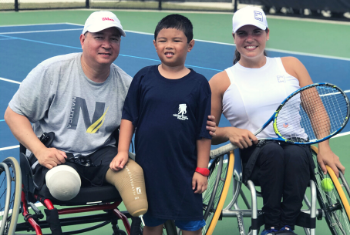Wounded Warrior Swings Back at Life On and Off the Court

When 9/11 happened, Elmer Dinglasan felt called to enlist, even though he already had a career as a medical technologist. With his 35th birthday a month away, he was almost too old to make the cut. After the Air Force recruiter turned him down, he went next door to the Navy recruitment office and enlisted.
As a professional with a bachelor’s degree in medical technology, he went in as a Navy Corpsman. He then opted to “go green” and work with the Marines, so he went through additional, rigorous training. “I didn’t want to be inside a hospital all the time, so I chose the Marines knowing I would go through more training and assume more risk.”
Elmer went from working at All Children’s Hospital in St. Petersburg, Florida, to wearing a Marines uniform with a Navy chest insignia – a Corpsman embedded with the Marines.
During his first deployment, he ran patrol with the Marines near the Euphrates River in Iraq. On a January night, Elmer was riding on a Humvee, third back from the front of the convoy, where it is expected that the Corpsman and first responder for the unit can be more protected.
The Humvee he was riding in veered just a few inches off the path to avoid bumpy terrain when it hit a roadside bomb. Everything flashed white inside his night vision goggles. The high-pitched noise in his ears didn’t let him hear what his teammates were yelling. Elmer was conscious throughout the ordeal and remembers seeing his boot in front of him and noticing it was facing the wrong way. He even helped his buddies mix his own pain medication.
He lost both legs in the attack.
He had tourniquets on and started thinking about what the rest of his life would be like as he was medically evacuated in a helicopter.
Two Visitors, One Purpose
Elmer remembers receiving two milestone visits while he was having surgeries and going through rehab in Bethesda, Maryland. One was from a Vietnam veteran who was also an amputee. He provided the inspiration during those early days to get up, try prosthetics, and go to physical therapy twice per day.
The other visitor brought Elmer a backpack with the Wounded Warrior Project® (WWP) logo on it. The backpack contained personal items that a medical evacuee would need in the hospital. It also delivered the message that Elmer was not alone and that others had his back.
Read the rest of the story in Homeland Magazine's February 2020 issue.
About WWP Adaptive Sports
Wounded warriors have access to free adaptive sports events throughout the country – through WWP as well as collaborations with the VA and other veterans service organizations. After each WWP adaptive sports clinic, warriors receive tools and assistance to continue improving their skills at home and in their communities, where they can take part in competitions or join adaptive sports teams. Warriors can also participate in other WWP programs that help them gain independence and improve their physical and mental wellness.
WWP staff meets warriors where they are on their journeys to recovery and helps them plan a path forward. Warriors never pay a penny for these services because they’ve paid their dues on the battlefield.